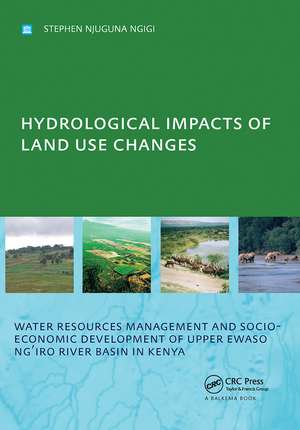Hydrological Impacts of Land Use Changes on Water Resources Management and Socio-Economic Development of the Upper Ewaso Ng'iro River Basin in Kenya: PhD: UNESCO-IHE Institute, Delft
Autor Stephen Njuguna Ngigien Limba Engleză Paperback – 2 noi 2006
| Toate formatele și edițiile | Preț | Express |
|---|---|---|
| Paperback (1) | 396.09 lei 6-8 săpt. | |
| CRC Press – 2 noi 2006 | 396.09 lei 6-8 săpt. | |
| Hardback (1) | 680.73 lei 6-8 săpt. | |
| CRC Press – 6 noi 2017 | 680.73 lei 6-8 săpt. |
Preț: 396.09 lei
Preț vechi: 513.21 lei
-23% Nou
Puncte Express: 594
Preț estimativ în valută:
75.79€ • 79.56$ • 62.91£
75.79€ • 79.56$ • 62.91£
Carte tipărită la comandă
Livrare economică 10-24 aprilie
Preluare comenzi: 021 569.72.76
Specificații
ISBN-13: 9780415409186
ISBN-10: 0415409187
Pagini: 148
Dimensiuni: 174 x 246 mm
Greutate: 0.29 kg
Ediția:1
Editura: CRC Press
Colecția CRC Press
ISBN-10: 0415409187
Pagini: 148
Dimensiuni: 174 x 246 mm
Greutate: 0.29 kg
Ediția:1
Editura: CRC Press
Colecția CRC Press
Public țintă
Postgraduate and UndergraduateCuprins
1. Introduction 2. Research Background and Study Area 3. Conceptual and Analytical Framework 4. Agro-hydrological Assessment of On-farm Storage RHM Systems 5. Agro-Hydrological Assessment of In-Situ RHM Systems 6. Hydro-Economic Analysis and Farmers’ Investment Options 7. Flood Storage and River Water Abstraction 8. Conclusions and Recommendations
Descriere
Offering an assessment of the hydrological impacts of land use changes on water resources management and socio-economic development of the upper Ewaso Ng’iro river basin in Kenya, this book explores the impact of irrigation on dry season river flows and highlights the challenge of flood storage strategies. While flood storage can reduce dry season irrigation water abstractions by more than a half, without affecting hydro-ecological functions downstream, unplanned flood harvesting may impact negatively on flood flow, being detrimental to natural ecosystems and groundwater downstream. The book discusses strategies to ensure equity allocation of basin water, creating a win-win situation for the water users affected.
























